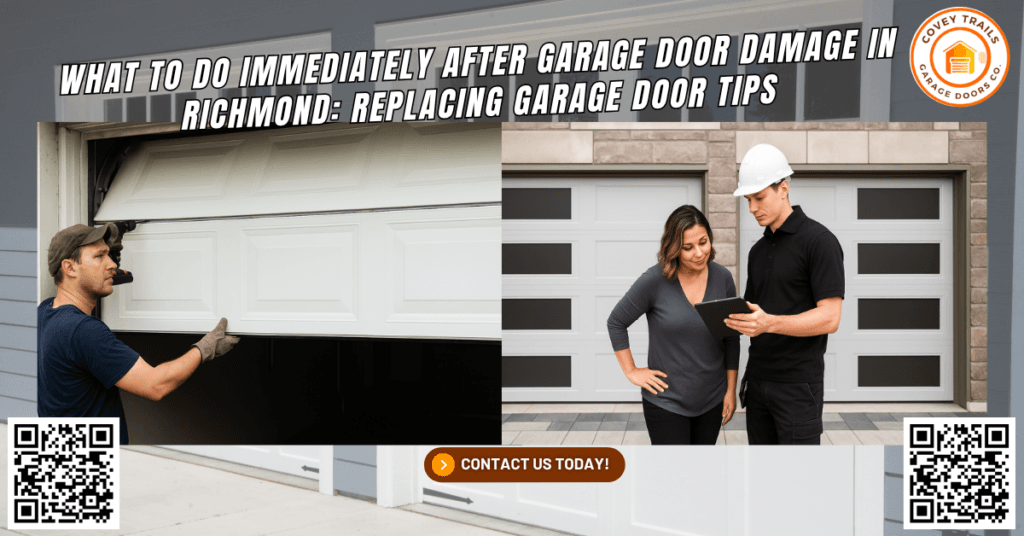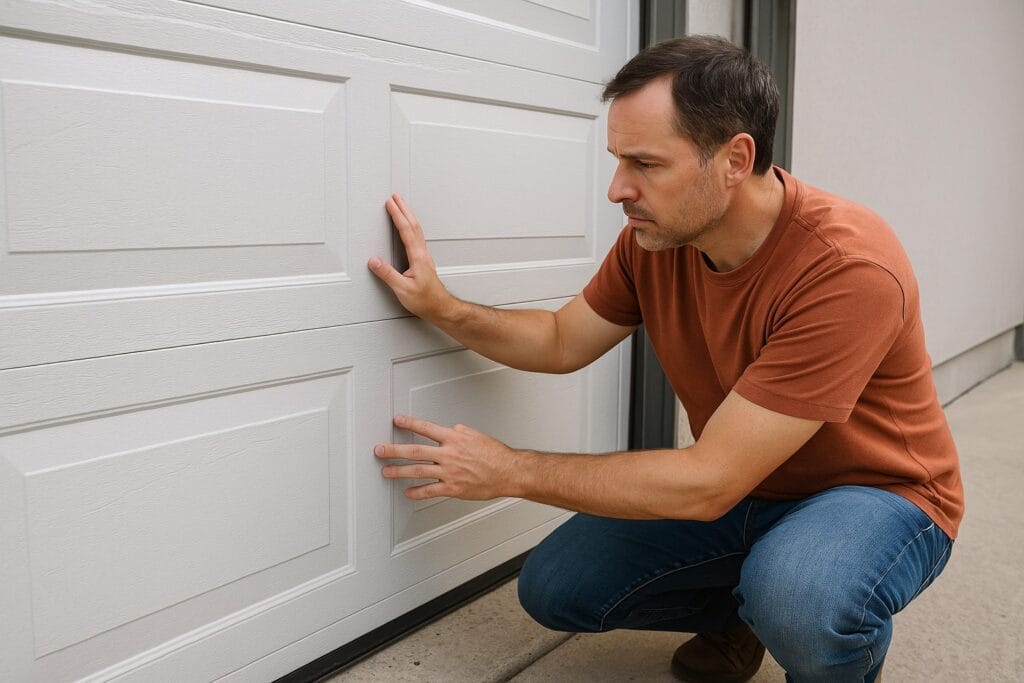What to Do Immediately After Garage Door Damage in Richmond: Replacing Garage Door Tips

It was just after a heavy thunderstorm rolled through Richmond when a local homeowner noticed something was off. The once smooth garage door operation now stuttered and groaned, the panels appeared dented, and the entire system felt misaligned. After closer inspection, they discovered that the garage door track had warped, the brackets had loosened, and one of the torsion springs was compromised. It’s a story we see often: storms, accidents, or wear-and-tear can damage your garage door suddenly, leaving your garage (and your home) exposed. In many cases, replacing garage door becomes the most effective solution to restore function, safety, and curb appeal.
Did you know that the garage door is the largest moving part of your home? It plays a key role not only in curb appeal but also in energy efficiency, security, and everyday garage door operation. A damaged door compromises insulation, leaves the garage door opener strained, and can pose safety risks. It’s more than an inconvenience, it’s a potential hazard.
If you’re dealing with garage door damage in Richmond, TX, it’s critical to act quickly and wisely. Whether it’s a dented garage door panel, a broken torsion spring, or a failing garage door opener, knowing the right steps can make all the difference. Let’s walk through a comprehensive guide to safely manage and replace your garage door for safe and smooth operation.
Step 1: Assess the Damage Safely and Thoroughly
Safety first, never underestimate the dangers involved in handling a damaged garage door system. Components like garage door springs, cables, and torsion tubes are under high tension. Attempting a DIY repair without the proper tools, such as a vise grip, power drill, and proper safety gear, can result in serious injury.
Begin with a visual check:
- Inspect all garage door panels for dents or cracks, especially the bottom panel and top section.
- Look at the vertical tracks and horizontal tracks for warping or misalignment.
- Check the brackets, flag bracket, and center bracket for rust, loosened bolts, or missing screws.
- Examine the garage door opener for operational issues. Does it hum without lifting? Does it respond inconsistently?

Also, listen for odd noises like screeching, grinding, or banging when operating the garage door. These can be signs of failing rollers, worn-out hinges, or issues with the torsion springs.
Step 2: Secure the Garage Door and Surrounding Area
A broken garage door doesn’t just hinder your daily routine, it threatens your home’s security. Until a repair or garage door replacement can be done, you’ll want to secure the door:
- Disconnect the garage door opener to prevent automatic operation.
- Use Vise-Grips to hold the door in place if it’s stuck halfway open.
- Clear the garage opening of vehicles, tools, and valuables to avoid damage.
- If the garage door sections are loose or dangling, brace them using temporary brackets or wood blocks.
- Cover open sections with a tarp to prevent exposure to weather and pests.
This temporary fix buys time and protects your belongings and family from danger.
Step 3: Document the Damage for Insurance or Warranties
Take detailed photos and notes before any repair or installation begins. Capture:
- The entire garage door system
- Close-ups of damaged tracks, panels, and brackets
- Broken springs, hinges, and cables
This documentation is useful for:
- Insurance claims if the damage was weather- or accident-related
- Manufacturer warrants that the garage door opener or components are still covered
- Quoting repairs or garage door installation services
Organizing this evidence also helps professional garage door technicians assess the situation quickly when they arrive.
Step 4: Decide Whether to Repair or Replace
In some cases, simple repairs like replacing a flag bracket, tightening bolts, or realigning a garage door track are enough. But often, especially when multiple components are damaged or the door is older, a full garage door replacement is more cost-effective and reliable.
Consider replacement if:
- The door panels are heavily dented or rusted
- The torsion springs or garage door opener have failed more than once
- You want better insulation and energy efficiency (look for doors with high R-values)
- Your current door lacks safety sensors, auto-reverse, or wind resistance features
In Richmond’s variable climate, energy-efficient garage doors with insulation help conserve energy, lower utility bills, and keep your garage comfortable year-round.
Step 5: Choose the Right Garage Door Replacement
Selecting the right garage door means weighing both form and function. A new garage door impacts your home’s curb appeal, security, and comfort. As you explore your options:
- Materials: Choose from steel, wood, fiberglass, or aluminum. Steel is durable and low-maintenance; wood offers a warm look but needs regular upkeep.
- Insulation: Look for high R-value doors. Double-layer or triple-layer insulated garage doors are best for energy savings.
- Design: Pick a style that matches your home carriage, contemporary, raised panel, or custom. Color and garage door panel texture affect overall aesthetic appeal.
- Functionality: Decide on manual vs. automatic garage door openers. Consider adding smart openers for remote access and monitoring.

Also, evaluate wind-load ratings and reinforced vertical tracks if your home is prone to storms.
Step 6: Professional Garage Door Installation Matters
A successful garage door installation involves more than hanging panels. It requires precision and experience. Our Covey Trails Garage Doors Co. team follows a step-by-step installation process that includes:
- Removing the old garage door
- Installing the bottom panel, followed by additional door sections
- Mounting hinges, brackets, and tracks
- Positioning the torsion tube and garage door springs
- Attaching the garage door opener, header bracket, and safety sensors
- Testing the operation, balance, and tension for smooth, quiet function
We use specialized tools like power drills, levels, and winding bars to ensure each component is properly aligned. This minimizes wear on your system and ensures a long-lasting solution.
Step 7: Understand Warranties and Maintenance Plans
After installation, it’s important to maintain your garage door system regularly. Our services include:
- Annual inspections
- Lubricating hinges, rollers, and springs
- Checking cables, panels, and tracks for signs of stress
- Testing garage door openers for proper sensitivity and response
We also offer warranty protection on both parts and labor, so you’re covered for unexpected issues.
Step 8: Prevent Future Garage Door Damage
Your garage door is an investment. Protect it with these tips:
- Don’t DIY spring repairs; always call a professional.
- Clean the garage door tracks and brackets every few months.
- Tighten any loose bolts, screws, or hinges as part of routine upkeep.
- Schedule seasonal tune-ups before extreme weather.
- Add protective bumpers or sensors to prevent vehicle damage.
Investing in a smart garage door opener also helps monitor your door’s performance and alerts you to potential malfunctions.
How Can Covey Trails Garage Doors Co. Help You?
When your garage door fails, Covey Trails Garage Doors Co. is your reliable partner for fast, professional service in Richmond, TX, and surrounding areas. Whether you need emergency repair, a complete garage door replacement, or want to upgrade to a more energy-efficient system, our expert team is ready.
With experience in residential and commercial garage doors, we handle:
- Broken garage door springs
- Damaged garage door panels
- Misaligned garage door tracks
- Faulty garage door openers
- Full garage door installation services
We offer affordable maintenance plans, strong warranty coverage, and 24/7 emergency services.
📍 Visit us in1093 Richmond, TX 77406 United States
📞 Call (713) 401-9063 for a FREE inspection
Secure your home, improve your curb appeal, and restore smooth garage door operation with Covey Trails Garage Doors Co., your local garage door experts.
Frequently Asked Questions (FAQs)
1. How long does it take to replace a garage door?
Typically, a professional garage door replacement takes between 3 to 6 hours, depending on the complexity and type of door system being installed.
2. Can I use my existing garage door opener with a new door?
In many cases, yes, but it depends on the compatibility of your opener with the new door’s weight and features.
3. What is the average lifespan of a garage door?
Most garage doors last 15 to 30 years with proper maintenance and regular service of components like springs, tracks, and openers.
4. Will replacing my garage door increase my home’s value?
Yes, garage door replacements consistently rank as one of the top home improvement projects for return on investment and curb appeal enhancement.
